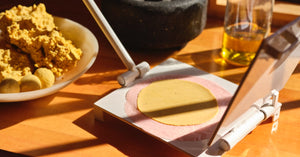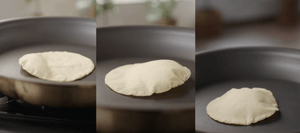Masa Feature : Corn-tine tamales with Mira Evnine
Masa Feature : Corn-tine tamales with Mira Evnine

May 15, 2020
I don't love tamales.
There, I said it.
Yes, I recognize the irony, and, no, it's not you--or your tamal--it's me. You're both great, really.
It's a texture thing. And, as far as texture is concerned, there are two more widely-known (though, to be sure, certainly not the only two) masa genres that tend to dominate the canon.
At one extreme, you have the spongey, cake-like tamales found throughout central Mexico/parts of northern Mexico, for example, made of coarsely-ground, dry nixtamal. (Fun fact: Though most popularly associated with pozole, the ultra-floury cacahuazintle landrace is often the corn of choice for this kind of masa, in the immediate region around Mexico City.) If you've ever been to a tortilleria that has a big bin of dry-looking masa for scooping by the pound or kilo, that's the stuff. It's similar in texture to the kind of masa that you'd also find well outside of Mexico, like Colombia, for instance.
At the other end of the spectrum, you'll encounter tamales that seem to be more about the filling than the masa itself. So much so, that the masa constitutes little more than a thin layer between the filling and the wrapper, which might just be a smooth banana leaf. The masa--also typically made of nixtamal, but more commonly with denser corn varieties than a pozolero--is a very fine grind like that you'd expect of a table tortilla masa. In fact, the same masa for tortillas is often used for this kind of tamal. This masa style is more prevalent throughout southern Mexico, in places like Oaxaca, Chiapas, Veracruz, Guerrero and the Yucatan. In keeping with my pastry-themed descriptions, it can have an almost fudge-like texture. It's dense and almost slightly gelatinous at times.
I've never liked the textures of cake or fudge, and I don't really have a sweet tooth, however, I do love masa. So let's just say that I passively like tamales.
But let's put my personal mishegas aside because this is all about you, not me, and MANY of you in corn-tine, including our very own COO, Danielle Dahlin, have asked if our Heirloom Corn Masa Harina can make tamales. Further, you've requested recipes on how to prepare it.
Yes.
So rather than hold you back from reaching full tamal potential, and in keeping with the collaborative nature of Masa Feature, I thought it timely to give our dear friend, Mira Evnine, a shout.
Mira is a bonafide masa mafiosa at large. By trade, she's a private chef, recipe tester, florist and Corn Symposium founder. She helped recipe test our little book on Nixtamal. Pre corn-tine, Mira lived in Brooklyn, NY, where, if you were as lucky as industry folks like Andrew Tarlow or Fany Gerson, she might prepare you tamales from homemade nixtamal.
These days, she's personal cheffing at an undisclosed location far from reach of her trusty molino, so we proceeded with Heirloom Corn Masa Harina from Masienda instead.
What I love about Mira’s approach, here, is that it's a fun compromise between the two masa versions I mentioned earlier. Masienda's masa harina is a very fine grind that you'd use for a table tortilla application, so it will resemble that regionally southern Mexico tamal vibe in some ways...but wait! The ratio of masa to filling is a bit more in line with central to northern Mexico—and it’s wrapped in a corn husk. A little cake, a little fudge, a lot of savory goodness.
We'll get to the kernel-to-masa process again, don't worry, and I'll be sure to keep providing additional preparation notes on every varietal we carry at Masienda, but I'm jazzed to sit back and watch corn-tine masa magic this week with our friend, Mira.
Oh, one more thing about tamales. Many, many traditional tamal recipes don’t call for any condiments or garnishes because the filling is, ostensibly, enough. This one doesn’t call for toppings, either, but I thrive on condiments. If you do too, go for it, and live your best life.
-Jorge
Corn-Tine Tamales by Mira Evnine
Corn-tine, USA--Tamales are normally a multi-step, two-day, marathon-esque commitment because, if you are going to make tamales, you might as well make a lot of tamales. However! If you make tamales using Masienda’s masa harina, it turns into a much more manageable project that cuts your prep time dramatically. If you're like me, this means that you won't feel so bad about preparing smaller batches at a time.
A few things: What follows is a rough recipe. And although I'm a recipe tester in pre-pandemic times, I didn't test this recipe, per se. These are more of my journal notes on how I prepare tamales at home. And, let's not forget, we're improvising a lot these days with the ingredients we do have, which will undoubtedly affect the feel of each batch we make. So don't forget to let your intuition guide you. No matter what direction you choose, the very experience of making a homemade tamal will almost certainly beat going to the store.
Additionally, because of the masa harina’s finer texture (as opposed to coarser freshly-milled masa for tamales), it is perfectly suited for more of a Oaxaca-style tamal which is usually folded into a banana leaf in a square tamal, as opposed to the corn-husked, enveloped kind we see most commonly being sold in markets or by street vendors throughout Mexico City, for example.
That said, what follows are notes from my making tamales en hojas de maiz, or corn husk. Some more notes on that below. This "recipe" makes 10 to 12 tamales and takes about 2 hours total of prep (assuming you have a filling handy).



